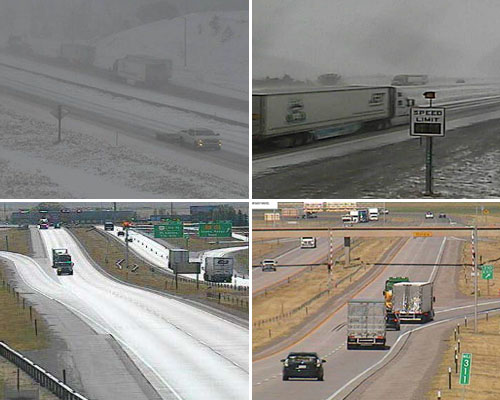Research Reports
Report Details
Abstract
 Adverse weather has long been recognized as one of the major causes of motor vehicle crashes due to its negative impact on visibility and road surface. Providing drivers with real-time weather information is therefore extremely important to ensure safe driving in adverse weather. However, identification of road weather and surface conditions is a challenging task because it requires the deployment of expensive weather stations and often needs manual identification and/or verification. Therefore, the primary objective of this research was to develop cost-effective systems capable of providing accurate weather and surface conditions in real time. First, a trajectory-level weather detection system was developed using only a single video camera mounted on the dashboard of the participant vehicles. Two texture-based features, histogram of oriented gradient (HOG) and local binary pattern (LBP), were extracted from images and used as classification parameters to train the weather detection models using several machine learning classifiers, such as gradient boosting (GB), random forest (RF), and support vector machine (SVM). In addition, a unique multilevel model, based on a hierarchical structure, was also proposed to increase detection accuracy. Evaluation results revealed that the multilevel model provided an overall accuracy of 89.2%, which is 3.2%, 7.5%, and 7.9% higher compared with the SVM, RF, and GB model, respectively, using the HOG features. Considering the LBP features, the multilevel model also produced the best performance with an overall accuracy of 91%, which is 1.6%, 8.6%, and 9% higher compared with the SVM, RF, and GB models, respectively. Afterward, the existing roadside webcams in Wyoming were utilized to develop several robust weather and surface detection systems by applying advanced deep learning techniques. Most U.S. departments of transportation (DOTs), including Wyoming DOT (WYDOT), have installed roadside webcams mostly for operational awareness. This study leveraged these easily accessible data sources to develop affordable automatic road weather and surface condition detection systems. The developed detection models are focused on three weather conditions: clear, light snow, and heavy snow; and three surface conditions: dry, snowy, wet/slushy. Several pre-trained convolutional neural network (CNN) models, including AlexNet, GoogLeNet, and ResNet18, were applied with proper modification via transfer learning to achieve the classification tasks. The best performance was achieved using ResNet18 architecture with an unprecedented overall detection accuracy of 97% for weather detection and 99% for surface condition detection. The proposed study has the potential to provide more accurate and consistent weather information in real time that can be made readily available to be used by road users and other transportation agencies. The proposed models could also be used to generate temporal and spatial variations of adverse weather for proper optimization of maintenance vehicle routes and time.
Adverse weather has long been recognized as one of the major causes of motor vehicle crashes due to its negative impact on visibility and road surface. Providing drivers with real-time weather information is therefore extremely important to ensure safe driving in adverse weather. However, identification of road weather and surface conditions is a challenging task because it requires the deployment of expensive weather stations and often needs manual identification and/or verification. Therefore, the primary objective of this research was to develop cost-effective systems capable of providing accurate weather and surface conditions in real time. First, a trajectory-level weather detection system was developed using only a single video camera mounted on the dashboard of the participant vehicles. Two texture-based features, histogram of oriented gradient (HOG) and local binary pattern (LBP), were extracted from images and used as classification parameters to train the weather detection models using several machine learning classifiers, such as gradient boosting (GB), random forest (RF), and support vector machine (SVM). In addition, a unique multilevel model, based on a hierarchical structure, was also proposed to increase detection accuracy. Evaluation results revealed that the multilevel model provided an overall accuracy of 89.2%, which is 3.2%, 7.5%, and 7.9% higher compared with the SVM, RF, and GB model, respectively, using the HOG features. Considering the LBP features, the multilevel model also produced the best performance with an overall accuracy of 91%, which is 1.6%, 8.6%, and 9% higher compared with the SVM, RF, and GB models, respectively. Afterward, the existing roadside webcams in Wyoming were utilized to develop several robust weather and surface detection systems by applying advanced deep learning techniques. Most U.S. departments of transportation (DOTs), including Wyoming DOT (WYDOT), have installed roadside webcams mostly for operational awareness. This study leveraged these easily accessible data sources to develop affordable automatic road weather and surface condition detection systems. The developed detection models are focused on three weather conditions: clear, light snow, and heavy snow; and three surface conditions: dry, snowy, wet/slushy. Several pre-trained convolutional neural network (CNN) models, including AlexNet, GoogLeNet, and ResNet18, were applied with proper modification via transfer learning to achieve the classification tasks. The best performance was achieved using ResNet18 architecture with an unprecedented overall detection accuracy of 97% for weather detection and 99% for surface condition detection. The proposed study has the potential to provide more accurate and consistent weather information in real time that can be made readily available to be used by road users and other transportation agencies. The proposed models could also be used to generate temporal and spatial variations of adverse weather for proper optimization of maintenance vehicle routes and time.
How to Cite
Ahmed, Mohamed, Md Nasim Khan, and Anik Das. Automated Real-Time Weather Detection Systems Using Artificial Intelligence, MPC-22-485. North Dakota State University - Upper Great Plains Transportation Institute, Fargo: Mountain-Plains Consortium, 2022.